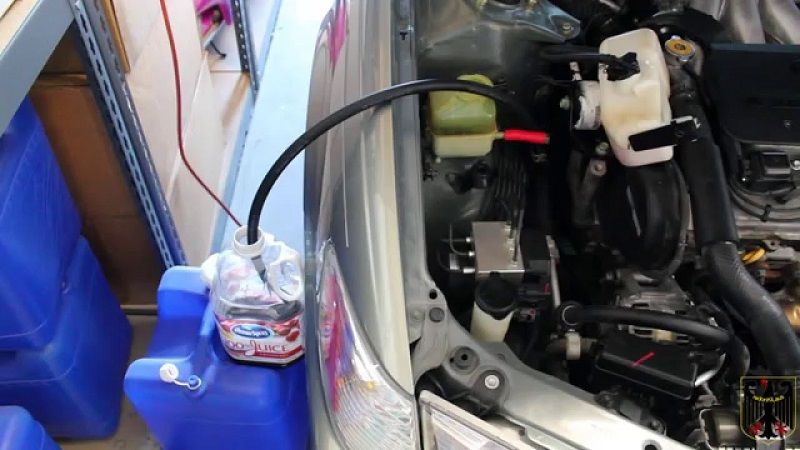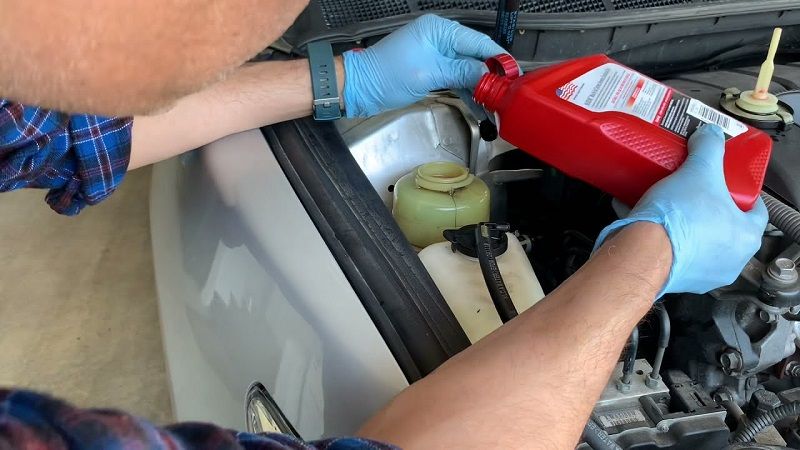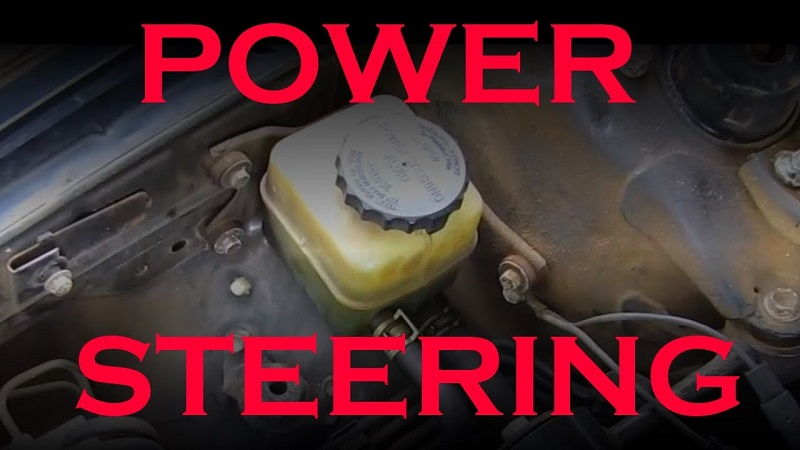This post contains affiliate links. This means I will make a commission at no extra cost to you should you click through and make a purchase [ “As an Amazon Associate, I earn from qualifying purchases.” ]. Read the full disclosure here.
Toyota Camry Power Steering Fluid – Understanding Power Steering Fluid In Toyota Camry GuideMechanic.Com Power steering is an essential system in modern cars, including the Toyota Camry, which enables drivers to steer their cars with minimal effort. The power steering system in Toyota Camrys relies on power steering fluid to operate correctly.
Understanding the importance of power steering fluid in your Camry is crucial if you want to maintain the health and longevity of your steering system. Basically, power steering fluid is designed to lubricate and protect the internal components of the power steering, which helps regulate the hydraulic pressure in the system.
Without the proper fluid levels, your steering system can be damaged over time, causing significant mechanical failure. Therefore, it’s essential to keep your Toyota Camry’s power steering fluid at the right level and replace it regularly to ensure that your steering functions effectively.
See Also: P0354 Toyota Camry: What Is P0354 And How Does It Impact
Any indication of power steering issues, such as hard steering or a whining sound, should be addressed promptly by a qualified mechanic.
Toyota Camry Power Steering Fluid
Definition

Power steering fluid is a vital component of any vehicle equipped with a power steering system. It is a type of hydraulic fluid that is specifically designed to aid in the movement of the steering system by providing the necessary pressure to operate the power steering pump.
It works by transmitting power from the engine to the steering system, which helps to reduce the amount of effort required to turn the steering wheel. Power steering fluid is typically comprised of a mixture of base oils and special additives that work together to lubricate and protect the system from wear and tear.
Regular maintenance and replacement of this fluid is essential to ensure the smooth operation of the power steering system and to avoid costly repairs in the future. While the specific type of power steering fluid required may vary depending on the make and model of the vehicle, it is important to always follow the manufacturer’s recommendations to ensure the integrity of the system.
In short, power steering fluid is a critical component of any vehicle equipped with power steering and should be regularly maintained to ensure the continued proper functioning of the system.
Types

Power steering fluid is a crucial component in power steering systems, as it is responsible for providing the necessary hydraulic pressure to assist with steering. There are various types of power steering fluids available on the market, each with its own unique characteristics and advantages.
See Also: VSC Off Toyota Corolla 2010
The most common type of power steering fluid is mineral oil-based fluid, which is used in many older vehicles. Mineral oil-based fluid is generally less expensive than other types of fluids, but it may not provide sufficient protection against wear and tear over time.
Another type of power steering fluid is synthetic fluid, which is designed to provide better protection against wear and tear and to work more efficiently in extreme temperatures. Synthetic fluid is generally more expensive than mineral oil-based fluid, but it provides better performance and protects the power steering system more effectively.
Some newer vehicles may require a specific type of power steering fluid, such as a fluid that is designed for use with electronic power steering systems. These fluids are specifically formulated to meet the unique needs of these systems and provide optimal performance and protection.
Regardless of the type of power steering fluid used, it is important to regularly check the fluid level and condition and to replace the fluid as needed to ensure optimal performance and protection for the power steering system.
By choosing the right type of power steering fluid and maintaining it properly, drivers can ensure safe and reliable steering performance in their vehicles.
Toyota Camry Power Steering Fluid
Components

Power steering fluid is an important component in the power steering system of a vehicle, which helps to ease the effort required to steer the vehicle. The power steering system consists of several components working together, including the power steering pump, steering gearbox or rack and pinion, power steering hoses, and power steering fluid.
The power steering pump helps to create hydraulic pressure in the power steering system, which is used to assist the steering effort of the driver. The power steering fluid is used to transfer this hydraulic pressure from the pump to the steering gearbox or rack and pinion, and allows for smooth and effortless steering.
See Also: Toyota Yaris Dashboard Lights
Without proper levels of power steering fluid, the power steering system can become damaged, leading to increased effort required for steering and potentially dangerous driving conditions.
Therefore, it is important to regularly check and maintain the power steering fluid levels to ensure the power steering system performs optimally.
Signs Of Power Steering Fluid Degradation

Power steering fluid is an important component of your Toyota Camry’s power steering system. It is responsible for providing hydraulic assistance to help you turn the steering wheel with ease. Over time, the power steering fluid in your Camry can degrade, and this can have adverse effects on your vehicle’s steering performance.
So, what are the signs of power steering fluid degradation in a Toyota Camry?Firstly, you may notice that your steering wheel is more difficult to turn than usual.
This is because degraded power steering fluid can create more resistance in the system, making it harder for the hydraulic pump to do its job effectively.
Additionally, you may hear a whining or groaning noise when you turn the steering wheel. This is often caused by air bubbles or metal particles in the power steering fluid, which can result from degradation.
Another sign of degraded power steering fluid is a noticeable decrease in steering responsiveness. You may find that it takes more effort to turn the steering wheel, and that your vehicle does not respond as quickly to your steering inputs.
This can be dangerous, especially in emergency situations where you need to quickly maneuver your vehicle.In summary, keeping an eye out for these signs of power steering fluid degradation can help you catch problems early on and take the necessary steps to keep your Toyota Camry’s power steering system in good working order.
It is important to maintain the proper level and quality of power steering fluid in your vehicle, and to have it changed regularly as recommended by the manufacturer.
-
Unusual Noises

Unusual noises coming from your vehicle can be indicative of a variety of problems. One such noise that may be particularly concerning is a whining or squealing sound coming from your Toyota Camry’s power steering system.
This noise can be caused by a variety of issues, such as low power steering fluid levels, a damaged power steering pump, or a worn-out belt. In the case of low power steering fluid levels, it may be necessary to add more fluid to the system to correct the problem.
See Also: Toyota Highlander Braking Power Low
It is important to address any unusual noises coming from your vehicle, as they may be a sign of a more serious issue that can lead to costly repairs down the line. If you are experiencing any unusual noises coming from your Toyota Camry, it is recommended to have it inspected by a qualified mechanic to determine the cause and address the issue as soon as possible.
-
Leaking Of Fluids

Leaking of fluids can occur in a variety of situations and contexts. In the medical field, one example of fluid leakage is spontaneous bacterial peritonitis (SBP), which develops in people with ascites , a condition characterized by excess fluid in the abdomen.
This condition can lead to the leakage of infectious fluids, causing inflammation and infection. In environmental science, leaking fluids can contaminate groundwater, potentially causing harm to plants, animals, and humans who rely on it.
In industrial settings, leaking fluids from equipment and machinery can pose a safety hazard, potentially leading to accidents or the release of harmful chemicals. Regardless of the context, it is important to address and prevent fluid leakage to minimize potential harm and ensure safety.
This can be achieved through proper maintenance of equipment, regular inspections, and prompt repairs in case of any identified leaks.
-
Difficulty In Steering

One of the common problems encountered while driving is difficulty in steering the vehicle. This can happen for a variety of reasons, such as mechanical issues with the steering system, low tire pressure, or problems with the alignment of the wheels.
In addition, driver fatigue or distraction can also make steering more difficult, as can adverse weather conditions such as heavy rain or wind. Whatever the cause, difficulty in steering can make driving more challenging and can also increase the risk of accidents.
See Also: P0330 Toyota: What Is The P0330 Error Code
It is important for drivers to seek prompt repairs for any issues with the steering system and to remain alert and focused while on the road, especially in challenging driving conditions.
Toyota Camry Power Steering Fluid
How To Check And Refill Power Steering Fluid
Power steering fluid is an essential component of any vehicle’s power steering system. It helps provide the necessary hydraulic pressure to assist in turning the wheels of your car, making it easier to steer.
When it comes to the Toyota Camry, it is important to regularly check and refill the power steering fluid to ensure the vehicle is running smoothly. Here are the steps you can take to check and refill the power steering fluid in a Toyota Camry:
- 1. Locate the power steering fluid reservoir, which can be found under the hood and typically near the rear of the engine bay.
- 2. Remove the cap from the reservoir and check the level of the fluid. The fluid level should be between the “low” and “high” marks on the dipstick.
- 3. If the fluid level is low, add power steering fluid until it reaches the “full” mark on the dipstick. Be careful not to overfill the reservoir.
- 4. Once the fluid has been added, replace the cap on the reservoir and start the engine. Turn the steering wheel left and right a few times to circulate the fluid throughout the system.
- 5. Check the fluid level again and add more power steering fluid if needed.By regularly checking and refilling the power steering fluid in a Toyota Camry, you can help maintain the performance and longevity of the vehicle’s power steering system. So, it is important to keep an eye on this key component of the car’s functionality.
Steps To Check Power Steering Fluid Levels
Checking the power steering fluid level is an important task to ensure that your vehicle’s power steering system operates smoothly. Here are the steps to check the power steering fluid levels. Firstly, consult your vehicle owner’s manual for the exact location of the power steering fluid reservoir.
After locating the reservoir, remove the cap and wipe the dipstick clean. Next, reinsert the dipstick into the reservoir and pull it out again to check the fluid level. Ensure that the fluid level is between the minimum and maximum marks on the dipstick.
If the level is low, add the recommended power steering fluid and recheck the level. It is essential to use the recommended fluid type to avoid potential damage to the power steering system.
Regularly checking the power steering fluid level will help prevent power steering failure while driving and extend the lifespan of your car’s power steering system. Remember to follow these steps regularly to keep the power steering fluid at the optimal level.
- Project Trucks for Sale Cheap - July 1, 2025
- Salvage Title Trucks for Sale - July 1, 2025
- Restored Classic Trucks for Sale - July 1, 2025
